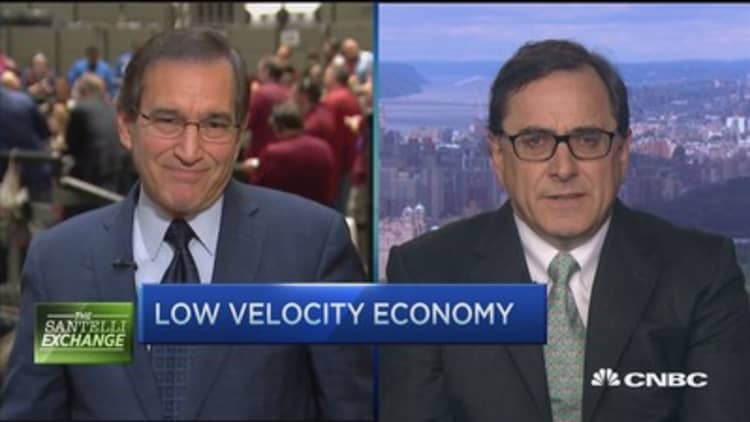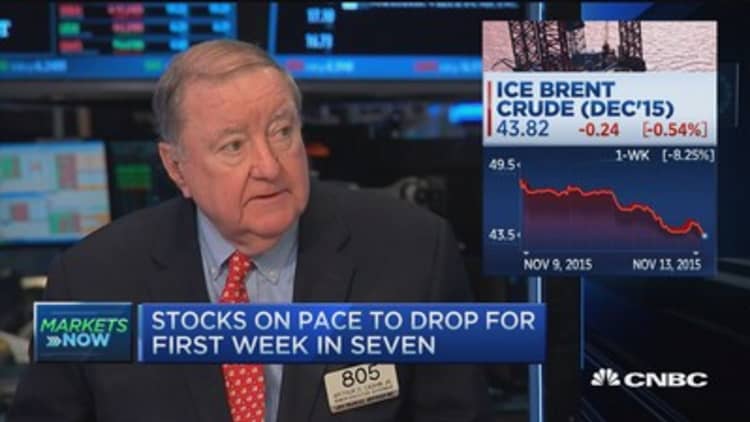


If the Federal Reserve persists on its path to raise interest rates in December, it will have to do so with little help from the economy.
Friday's economic data brought a fresh set of reminders that growth remains muted. Consumers spent less than expected in October and price pressure remains muted.
As a result, traders are growing a bit less confident about the prospect that the Federal Open Market Committee will indeed hike rates for the first time since going to near zero in late 2008.
Futures at the CME now are pricing in a 64 percent probability of a move, down from as high as 72 percent last Friday after an October rebound in jobs creation boosted expectations the Fed would tighten.
The enthusiasm that conditions were good enough to give the central bank a green light diminished as data show the prospects of deflation in the pipeline and a consumer still unwilling to commit to strong spending. Retail sales increased just 0.1 percent in October, while the producer price index actually fell, continuing a trend.
"What a turn of events?!" Lindsey Piegza, chief economist at Stifel Fixed Income, said in a note. "Just when the market is convinced the Fed will raise rates at year-end based on one good employment report, we are quickly reminded that there's more to the equation than just a one-off nonfarm payroll increase."
The 271,000 increase in October payrolls helped offset weak reports from the previous two months. But the Fed has been more focused on the pace of wage gains than it has headline job creation numbers, and the picture on the consumer remains muddled. The conditions have collided to put pressure on financial markets — no small factor in Fed deliberations — with the down about 0.7 percent midday Friday.
The payrolls report also showed a 2.5 percent annualized gains in average hourly wages, but that did not translate into stronger spending. Vehicle, general merchandise and gasoline sales fell sharply, offsetting gains in restaurants, materials and furniture.
At the same time, producer prices have been facing downward pressure. The producer price index dropped 0.4 percent for the month and 1.6 percent on an annualized basis.
"The pace of retail spending has been slowing on a trend basis since the middle of 2014 and more rapidly on a three-month rate-of-change basis since the middle of Q2'15. The reason why is fairly simple — the pace of job growth has slowed and this means growth in total consumer income has slowed as well," said Steve Blitz, chief economist at ITG Investment Research. "Less income growth, less retail spending on the stuff we want to buy." Blitz believes the Fed probably will hike in December, but the latest numbers complicate the picture.
To be sure, several economists were quick to write off the Friday numbers as not being representative of the overall economic picture. The Atlanta Fed is projecting fourth-quarter growth of 2.3 percent, which would place it as second best of the year.
"We're not concerned or alarmed by the modest 0.1 percent rise in sales last month. If you exclude the (truly questionable) auto and gasoline components, sales increased 0.3 percent, close to the 0.4 percent most forecasters expected," said Bernard Baumohl, chief global economist at the Economic Outlook Group. "Our take is that the propensity of consumers to spend is a lot stronger than the advance retail sales numbers suggest."
As for Fed watchers, then, it's probably a case of back to the drawing board.
Next week's consumer price index probably will carry more weight in determining the path of price inflation. And then it's hold-your-breath time for the November payrolls report, the last one the Fed will see before convening at the Dec. 15-16 FOMC meeting and the final chance to see whether American workers are seeing sustained growth in their paychecks.
"Higher wages for employees will also give employers incentives to at least hold steady on pricing with selective price increases likely a possibility," Peter Boockvar, chief market analyst at The Lindsey Group, said in a note. "Thus, I continue to believe that the inflation/deflation debate is not black or white and there is more than just a touch of gray in between."





